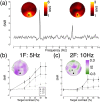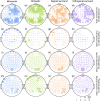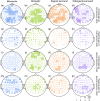Steady-state measures of visual suppression
- PMID: 34644292
- PMCID: PMC8544832
- DOI: 10.1371/journal.pcbi.1009507
Steady-state measures of visual suppression
Abstract
In the early visual system, suppression occurs between neurons representing different stimulus properties. This includes features such as orientation (cross-orientation suppression), eye-of-origin (interocular suppression) and spatial location (surround suppression), which are thought to involve distinct anatomical pathways. We asked if these separate routes to suppression can be differentiated by their pattern of gain control on the contrast response function measured in human participants using steady-state electroencephalography. Changes in contrast gain shift the contrast response function laterally, whereas changes in response gain scale the function vertically. We used a Bayesian hierarchical model to summarise the evidence for each type of gain control. A computational meta-analysis of 16 previous studies found the most evidence for contrast gain effects with overlaid masks, but no clear evidence favouring either response gain or contrast gain for other mask types. We then conducted two new experiments, comparing suppression from four mask types (monocular and dichoptic overlay masks, and aligned and orthogonal surround masks) on responses to sine wave grating patches flickering at 5Hz. At the occipital pole, there was strong evidence for contrast gain effects in all four mask types at the first harmonic frequency (5Hz). Suppression generally became stronger at more lateral electrode sites, but there was little evidence of response gain effects. At the second harmonic frequency (10Hz) suppression was stronger overall, and involved both contrast and response gain effects. Although suppression from different mask types involves distinct anatomical pathways, gain control processes appear to serve a common purpose, which we suggest might be to suppress less reliable inputs.
Conflict of interest statement
The authors have declared that no competing interests exist.
Figures









